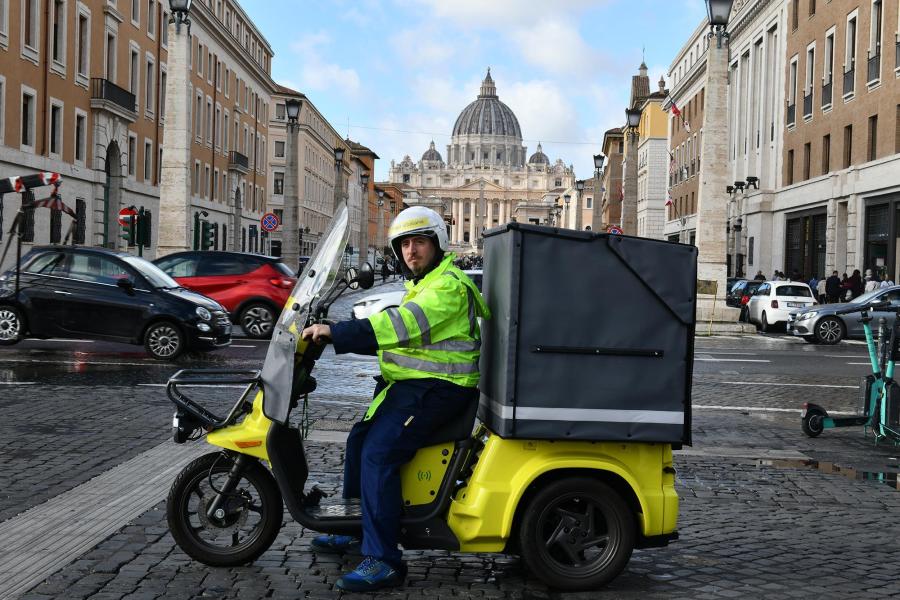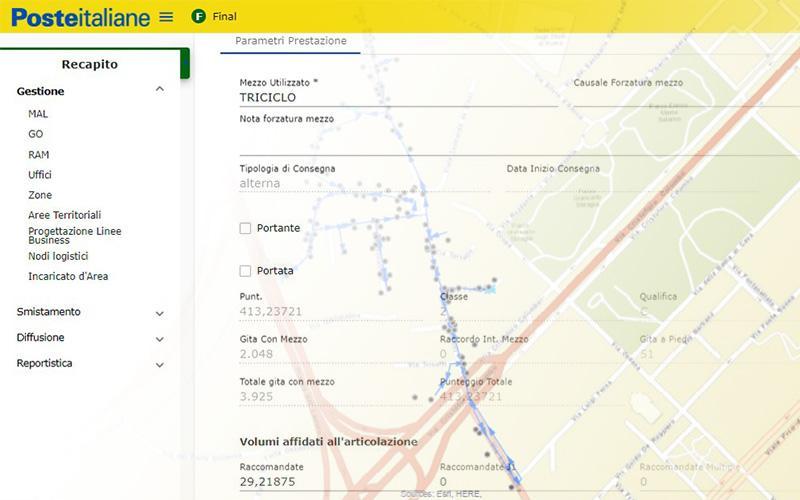Poste italiane launches an electric fleet for its mail carriers to cut emissions and meet growing demand for mail and parcels across Italy
It’s late Autumn, but still warm in Rome, the air crisply clear. The sun is piercing through the clouds on the terracotta-coloured houses in a narrow street of the Bravetta residential district. A couple of electric tricycles, roughly the size of a golf buggy, are silently helping postal staff deliver letters and parcels on their rounds.
Hundreds of electric tricycles and vehicles will soon populate a dozen districts in Rome, of which 57 will be in the Maggiolino distribution centre, which serves the Nomentana where Anna Manghetti lives. “It’s really exciting to see these new tricycles making their way into our daily deliveries,” she says, “a good cause to work for.”
Manghetti is head of finance at Poste Italiane, the largest logistics operator in the country and a leading player in the financial, insurance and payment services sector. Thanks to a €100 million loan from the European Investment Bank in March, Poste Italiane was able to replace its traditional fuel and petrol fleet with zero-emissions tricycles and vehicles.
“As the EU climate bank, we’re proud to support Poste Italiane’s ambitious decarbonisation plan,” says Giovanni Aldeghi, the senior European Investment Bank officer who has worked on the EU bank’s largest ever financing of a zero-emission mobility platform.
How green is our parcel?
The trickiest part of a parcel’s journey from warehouse to doorstep is the so-called “last mile”, the final step in the delivery process from a distribution centre to the recipient.
The boom in online shopping since the COVID-19 pandemic has worsened transport-related carbon emissions. Cities and logistics companies have struggled with unnecessary delivery journeys, congestion, parking and local residents’ concerns about noise and air pollution.
If the last mile delivery were more efficient and greener, cities would be healthier and more liveable. The idea started spinning through Manghetti’s mind during summer 2020.
The Poste Italiane Green Mobility project has been supervised by Chief Executive Matteo Del Fante and the team reporting to Chief Financial Officer Camillo Greco with the backing of Giuseppe Lasco, Joint General Manager and Marcello Grosso, Head of Group Sustainable Development, Risk and Compliance.
The Green Mobility project is about the replacement of the company’s traditional fuel and petrol vehicles with 4 150 electric vehicles for deliveries in cities and their surroundings. This also includes the associated charging stations and IT platform at a total cost of €145 million.
“It's a rather small sum which can go a long way,” says Manghetti about Poste Italiane’s first green finance operation.

Manghetti (second row, second from left to right) is head of finance at Poste Italiane, the largest logistics operator in the country and a leading player in the financial, insurance and payment services sector.
Unique financing
The EU bank’s loan to Poste Italiane has a number of unique features:
- It covers the rental fees for the renewal of the electric fleet, the installation of the associated recharging points and IT platform
- It finances the leasing fees of the electric fleet, which are accounted for in the assets as rights of use
- It is higher (69%) than the Bank’s 50% standard financing ceiling, to help Poste Italiane speed up its green transition.
The plan is ambitious: to reduce the emissions produced by the postal delivery fleet by 40% thanks to the use of zero-emission and hybrid vehicles—although hybrids are not part of the EIB-financed project. The ultimate goal is carbon neutrality by 2030, ahead of the timeline set by the European Union.

The project will reduce air pollution, greenhouse gas emissions and noise in city centres, saving 3 000 tonnes of carbon emissions each year. This is equivalent to the average emissions of 3 000 passengers on return flights from Paris to New York.
“This is the future”
As of mid-October 2022, 1 100 electric vehicles are already delivering mail in 70 Italian cities and towns, including Turin, Florence, Trieste, Bologna, Naples and, of course, Rome.
The electricity used to charge these vehicles comes from renewable sources. The project will reduce air pollution, greenhouse gas emissions and noise in city centres, saving 3 000 tonnes of carbon emissions each year. This is equivalent to the average emissions of 3 000 passengers on return flights from Paris to New York.
To further reduce its environmental impact, Poste will also use the European Investment Bank financing to support its IT platform. The innovative model optimizes the postman’s route according to mail traffic, distance, type of road, traffic restrictions and parcel volume. The route planning integrates the range limits of electric vehicles and the availability of charging stations.

The route planning integrates the range limits of electric vehicles and the availability of charging stations.
“The success of this project depends on the interpretation of a big amount of data gathered in real time,” says Tiago Lopes, a European Investment Bank senior engineer who has worked on this operation. “This is the future.”
As technology evolves and battery capacity increases in the years to come, Lopes’ idea is to “go the extra mile”: to extend the project to the middle-mile fleet (from the warehouse to the local post office) and to the first-mile fleet (from the factory to the distribution centre).
Meanwhile, Manghetti’s son has just graduated in environmental engineering and is ready to contribute to Italy’s green transition too.
